28 The Rococo and Neoclassicism
Rococo
Rococo in French Decoration
Rococo salons are known for their elaborate detail, serpentine design work, asymmetry, and predisposition to lighter, pastel, or gold-based color palettes.
Key Points
- After the reign of Louis XIV, the wealthy and aristocratic moved back to Paris from Versailles and began decorating their homes in the new Rococo style that was associated with King Louis XV.
- The notion of the salon is an Enlightenment era ideal that transformed the salon, or living room, into the central space for aristocracy to entertain guests and engage in intellectual conversation.
- Rococo interiors are highly unified in nature, and represent the coming together of a number of decorative arts.
- As with other Rococo art forms, the color palette is lighter, the lines are curvaceous (‘S’ curve), and the decoration is excessive.
- Furniture rose to new heights in the period and emphasized lighthearted frivolity.
- Furniture, friezes, sculpture, metalwork, wall, and ceiling decoration are woven together stylistically in the Rococo salon.
Key Terms
- asymmetry: Lacking a common measure between two objects or quantities; incommensurability.
- serpentine: Sinuous; curving in alternate directions.
- mahogany: Any of various tropical American evergreen trees, of the genus Swietenia, having a valuable hard red-brown wood.
- palette: The range of colors in a given work or body of work.
In 18th century Europe, the Rococo style became prevalent in interior design, painting, sculpture, and the decorative arts. A reaction to the rigidity of Baroque style, the frivolous and playful Rococo first manifested itself with interior design and decorative work. In French, the word salon simply means living room or parlor, and Rococo salons refer to central rooms that are designed in the Rococo style. In addition, the notion of the ‘salon’ is an Enlightenment era ideal that transformed the living room into the central space for aristocracy to entertain guests and engage in intellectual conversation. The idea that one’s architectural surroundings should encourage a way of life, or reflect one’s values, was the philosophy of the time.
The Rococo interior reached its height in the total art work of the salon. Rococo salons are characterized by their elaborate detail, intricate patterns, serpentine design work, asymmetry, and a predisposition to lighter, pastel, and gold-based color palettes.
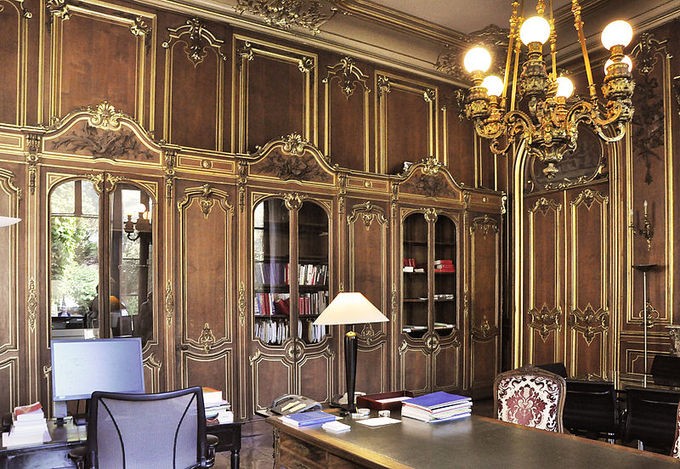
As another means of reflecting status, furniture rose to new heights during the Rococo period, emphasizing the lighthearted frivolity that was prized by the style. Furniture design became physically lighter and upholstered for the first time; comfort became an important issue as well as furniture that was free-standing allowing for it to be easily moved around for gatherings. Furniture in the Rococo period moved away from the wall in order to accentuate the lighthearted and versatile atmosphere that was desired by the aristocracy. Mahogany became the most widely used medium due to its strength, and mirrors also became increasingly popular.
Rococo salons often employed the use of asymmetry in design, which was termed contraste. Interior ornament included the use of sculpted forms on ceilings and walls, often somewhat abstract or employing leafy or shell-like textures. Two excellent examples of French Rococo are the Salon de Monsieur le Prince in the Petit Château at Chantilly, decorated by Jean Aubert; and the salons in the Hotel Soubise, Paris, by Germain Boffrand. Both of these salons exhibit typical Rococo style with walls, ceilings, and moulding decorated with delicate interlacings of curves based on the fundamental shapes of the ‘S,’ as well as with shell forms and other natural shapes.
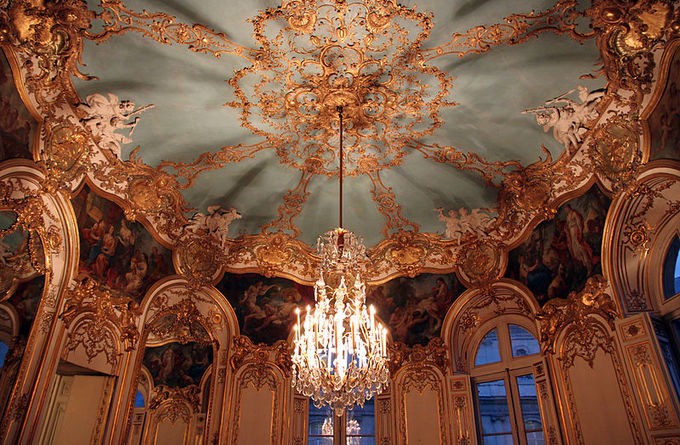
In France, the style began to decline by the 1750s. Criticized for its triviality and excess in ornament, Rococo style had already become more austere by the 1760s, as Neoclassicism began to take over as the dominant style in France and the rest of Europe.
The Rococo style became popular all over Europe, but was particularly evident in rooms from Germany and Austria. Here François Cuvilliés the Elder has designed a pastel-colored room with gilded moldings that seem to crawl up the wall and onto the ceiling. Note the mirrors that multiply and excentuate the accumulation of detail.
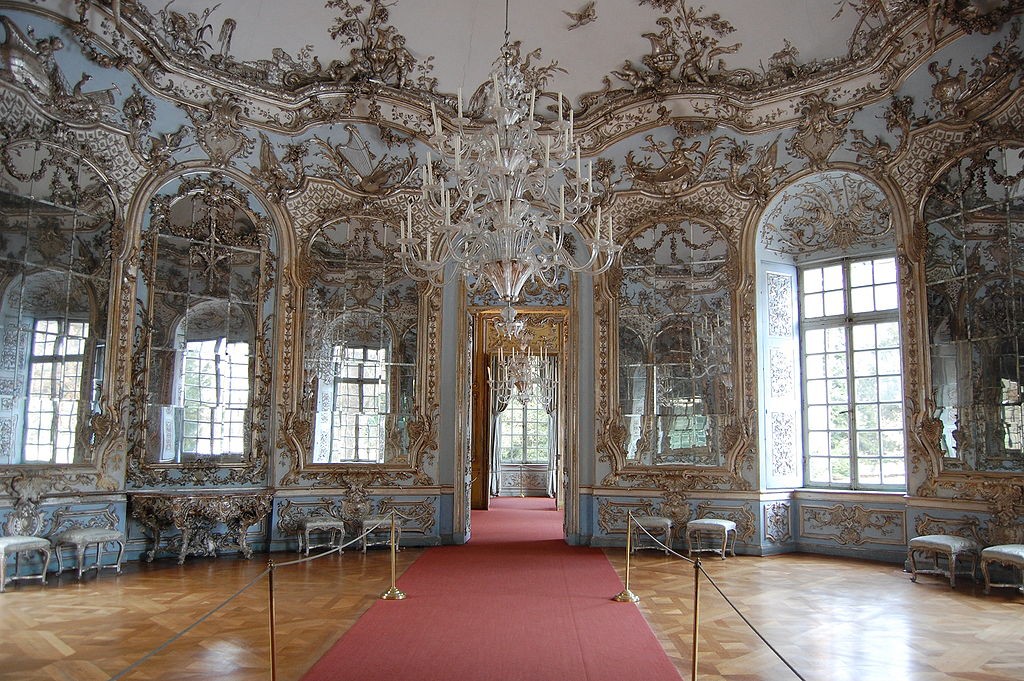
Rococo in Painting and Sculpture
Rococo style in painting echoes the qualities evident in other manifestations of the style including serpentine lines, heavy use of ornament as well as themes revolving around playfulness, love, and nature.
Key Points
- Rococo style developed first in the decorative arts and interior design, and its influence later spread to architecture, sculpture, theater design, painting, and music.
- Rococo style is characterized by elaborate ornamentation, asymmetrical values, pastel color palette, and curved or serpentine lines.
- Rococo art works often depict themes of love, classical myths, youth, and playfulness.
- Antoine Watteau is considered to be the first great Rococo painter who influenced later Rococo masters such as Boucher and Fragonard.
- Rococo sculpture makes use of very delicate porcelain instead of marble or another heavy medium.
Key Terms
- Rococo: A style of baroque architecture and decorative art, from 18th century France, having elaborate ornamentation.
- pastel: Any of several subdued tints of colors, usually associated with pink, peach, yellow, green, blue, and lavender.
- serpentine: Sinuous; curving in alternate directions.
Rococo Painting
Painting during the Rococo period has many of the same qualities as other Rococo art forms such as heavy use of ornament, curved lines and the use of a gold and pastel-based palette. Additionally, forms are often asymmetrical and the themes are playful, even witty, rather than political, as in the case of Baroque art. Themes relating to myths of love as well as portraits and idyllic landscapes typify Rococo painting.
Antoine Watteau
Antoine Watteau is considered to be the first great Rococo painter. His influence is visible in the work of later Rococo painters such as Francois Boucher and Honore Fragonard. Watteau is known for his soft application of paint, dreamy atmosphere, and depiction of classical themes that often revolve around youth and love, exemplified in the painting Pilgrimage to Cythera.
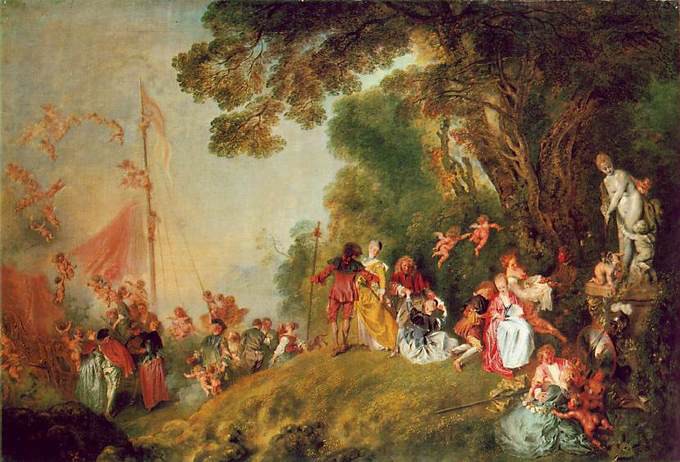
Jean-Honoré Fragonard
Fragonard was the last of the three Rococo painters to have the patronage of the court. He painted this work, The Pursuit, as part of a series of four paintings intended to decorate the private salon of Madame du Barry, Louis XV’s mistress. By the time Fragonard had completed the commission the superficiality and sly sexual innuendo of the Rococo style had gone out of favor and du Barry hired another artist to decorate the rooms. Sexual iconography was part of the purpose of the kind of work popular during the height of the Rococo period. Venuses and Cupids were prominent, especially as garden ornaments at scenes of secret trysts. A fountain would suggest the female sex and flowing water, seminal fluid. Baskets, hats, rakes, and other seemingly commonplace items would have been understood as symbols of body parts and sexual acts. The ‘hidden’ quality of these signs – or at least the idea that only the wealthy, noble elite were in on the joke – was characteristic of the superficiality of the entire movement.
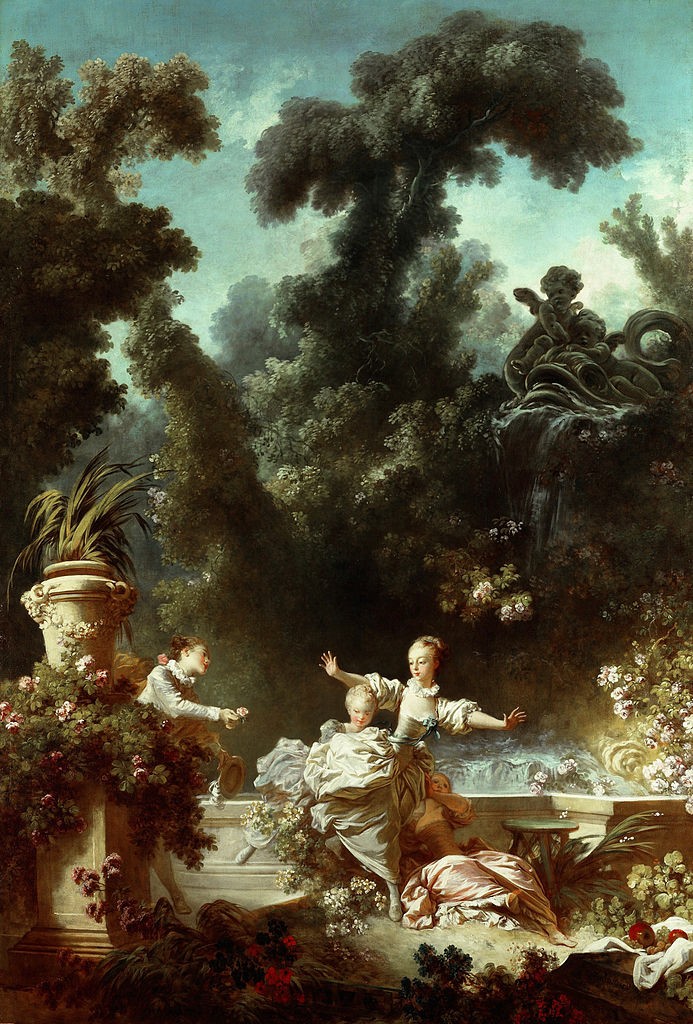
The period that followed the Rococo was inspired by both events in the world and a desire for more content and serious purpose in both life and art. The political moment in France was one that would see the most serious and bloody consequences of a mismanagement of public affairs and would be reflected in the increasingly political and moral-laden art of that period.
Neoclassicism
Neoclassicism refers to movements in the arts that draw inspiration from the “classical” art and culture of ancient Greece and Rome.
Key Points
- The height of Neoclassicism coincided with the 18th century Enlightenment era, and continued into the early 19th century.
- The rediscovery and archeological uncovering of Roman artifacts at Pompeii and Herculanaeum would spur a desire for all things Greco-Roman in the rest of Europe.
- With the increasing popularity of the Grand Tour, it became fashionable to collect antiquities as souvenirs, which spread the Neoclassical style through Europe and America.
- Neoclassicism spanned all of the arts including painting, sculpture, the decorative arts, theatre, literature, music, and architecture.
- Generally speaking, Neoclassicism is defined stylistically by its use of straight lines, minimal use of color, simplicity of form and, of course, an adherence to classical values and techniques.
- Rococo, with its emphasis on asymmetry, bright colors, and ornamentation is typically considered to be the direct opposite of the Neoclassical style.
Key Terms
- Grand Tour: The traditional tour of Europe undertaken by mainly upper-class European young men of means. The custom flourished from about 1660 until the advent of large-scale rail transit in the 1840s.
- Enlightenment: A concept in spirituality, philosophy, and psychology related to achieving clarity of perception, reason, and knowledge.
- Rococo: A style of baroque architecture and decorative art, from 18th century France, having elaborate ornamentation.
The classical revival, also known as Neoclassicism, refers to movements in the arts that draw inspiration from the “classical” art and culture of ancient Greece and Rome. The rediscovery and archeological uncovering of Roman artifacts at Pompeii and Herculanaeum would spur a desire for all things Greco-Roman in the rest of Europe. The height of Neoclassicism coincided with the 18th century Enlightenment era, and continued into the early 19th century. The dominant styles during the 18th century were Baroque and Rococo. The latter, with its emphasis on asymmetry, bright colors, and ornamentation is typically considered to be the direct opposite of the Neoclassical style, which is based on order, symmetry, and simplicity. With the increasing popularity of the Grand Tour, it became fashionable to collect antiquities as souvenirs. This tradition of collecting laid the foundations for many great art collections and spread the classical revival throughout Europe and America.
Neoclassicism grew to encompass all of the arts, including painting, sculpture, the decorative arts, theatre, literature, music, and architecture. The style can generally be identified by its use of straight lines, minimal use of color, simplicity of form and, of course, its adherence to classical values and techniques.
In music, the period saw the rise of classical music and in painting, the works of Jaques-Louis David became synonymous with the classical revival. However, Neoclassicism was felt most strongly in architecture, sculpture, and the decorative arts, where classical models in the same medium were fairly numerous and accessible. Sculpture in particular had a great wealth of ancient models from which to learn, however, most were Roman copies of Greek originals.
Neoclassical architecture was modeled after the classical style and, as with other art forms, was in many ways a reaction against the exuberant Rococo style. The architecture of the Italian architect Andrea Palladio became very popular in the mid 18th century. Additionally, archaeological ruins found in Pompeii and Herculaneum informed many of the stylistic values of Neoclassical interior design based on the ancient Roman rediscoveries.
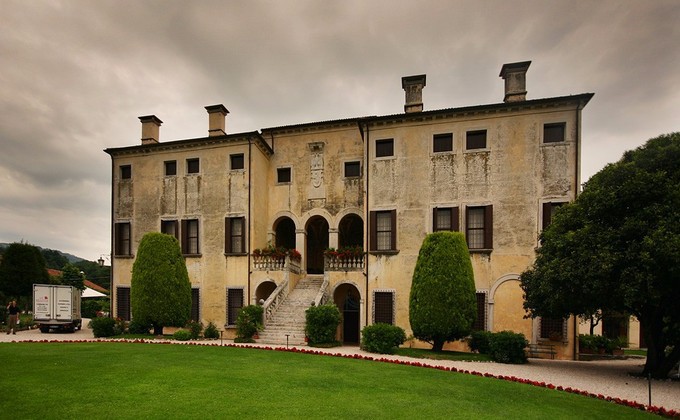
Neoclassical Paintings
Neoclassical painting, produced by men and women, drew its inspiration from the classical art and culture of ancient Greece and Rome.
Key Points
- Neoclassical subject matter draws from the history and general culture of ancient Greece and Ancient Rome. It is often described as a reaction to the lighthearted and “frivolous” subject matter of the Rococo.
- Neoclassical painting is characterized by the use of straight lines, a smooth paint surface, the depiction of light, a minimal use of color, and the clear, crisp definition of forms.
- The works of Jacques-Louis David are usually hailed as the epitome of Neoclassical painting.
- David attracted over 300 students to his studio, including Jean-Auguste- Dominique Ingres, Marie-Guillemine Benoist, and Angélique Mongez, the last of whom tried to extend the Neoclassical tradition beyond her teacher’s death. Élizabeth Vigée Le Brun became the Queen’s court painter.
Key Terms
- Enlightenment: A philosophical movement in 17th and 18th century Europe. Also known as the Age of Reason, this was an era that emphasized rationalism.
Background and Characteristics
The French Neoclassical style would greatly contribute to the monumentalism of the French Revolution, with the emphasis of both lying in virtue and patriotism.
Neoclassical painting is characterized by the use of straight lines, a smooth paint surface hiding brush work, the depiction of light, a minimal use of color, and the clear, crisp definition of forms. Its subject matter usually relates to either Greco- Roman history or other cultural attributes, such as allegory and virtue. The softness of paint application and light-hearted and “frivolous” subject matter that characterize Rococo painting is recognized as the opposite of the Neoclassical style. The works of Jacques-Louis David are widely considered to be the epitome of Neoclassical painting. Many painters combined aspects of Romanticism with a vaguely Neoclassical style before David’s success, but these works did not strike any chords with audiences. Typically, the subject matter of Neoclassical painting consisted of the depiction of events from history, mythological scenes, and the architecture and ruins of ancient Rome.
The School of David
Neoclassical painting gained new momentum with the great success of David’s Oath of the Horatii at the Paris Salon of 1785. The painting had been commissioned by Louis XVI in an effort to remind the increasingly restive French populace of their civic duty to their country. Sadly for Louis, it had the opposite effect. David had twice been to Italy and was steeped in the historical painting style of the old masters. He created this work in a style that was the perfect combination of idealized structure and dramatic effect. The painting created an uproar, and David was proclaimed to have perfectly defined the Neoclassical taste in his painting style. He thereby became the quintessential painter of the movement. In The Oath of the Horatii, the perspective is perpendicular to the picture plane. It is defined by a dark arcade behind several classical heroic figures. There is an element of theatre, or staging, that evokes the grandeur of opera. David became the leading French painter and enjoyed a great deal of government patronage. Over the course of his long career, he attracted over 300 students to his studio.
David would become increasingly politicized and with the outbreak of revolution in 1789 he became the chronicler of those events as well as the creator of the many parades and pageants that were intended to keep the French people enthusiastic for the revolution, even as it got bloodier. David would be a protégé of the Jacobeans led by Robespierre. When Robespierre himself fell victim to the mania of the Reign of Terror, as the last days of the revolution before Louis XVI, Marie Antoinette and their family would all be sent to their deaths, David was arrested and imprisoned. Perhaps with the intervention of his estranged wife, David lived to paint the next ruler to take charge in France after the Revolution – Napoleon Bonaparte.
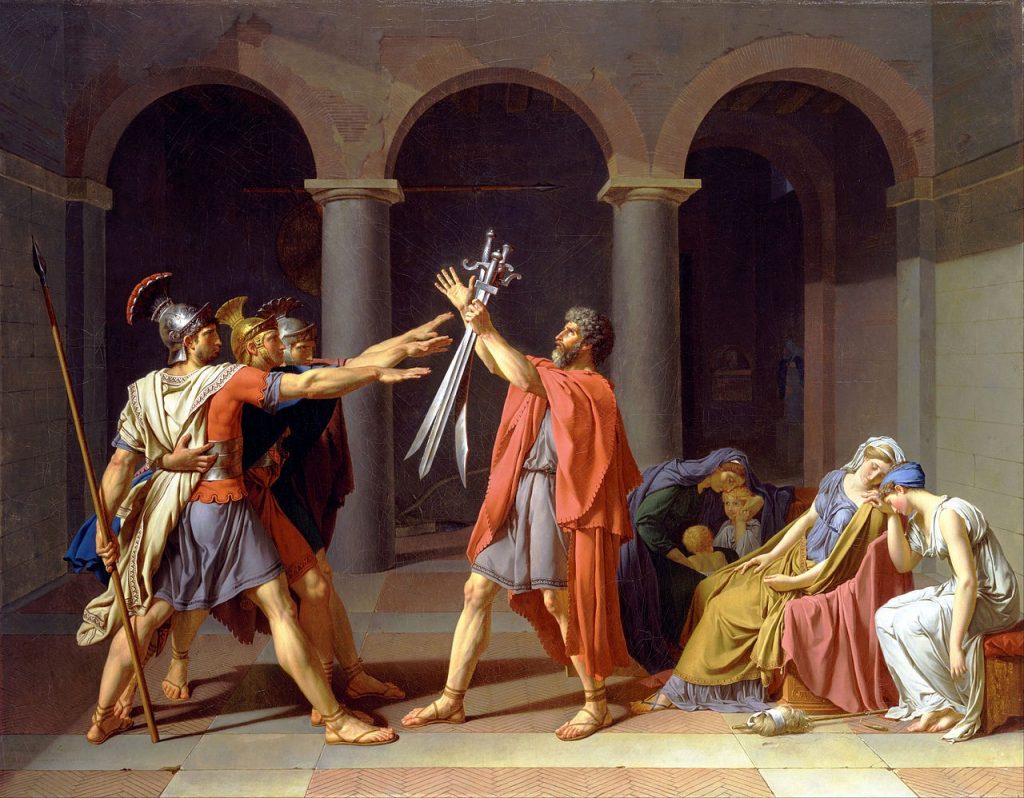
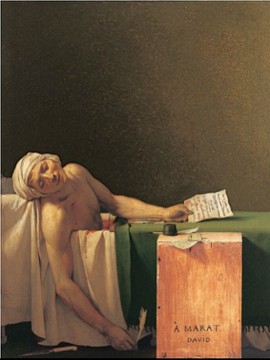
Marat was one of the facilitators of the Reign of Terrors. He suffered from a skin disease that required him to spend much time in a bath; Charlotte Corday, a country girl horrified by the bloody events taking place in Paris, came to the city, gained entry to Marat’s rooms and stabbed him to death. She was promptly arrested and guillotined, but David paints Marat moments after his execution as a martyr of the Revolution.
While tradition and the rules governing the Académie Française barred women from studying from the nude model (a necessity for executing an effective Neoclassical painting), David believed that women were capable of producing successful art of the style and welcomed many as his students. Among the most successful were Marie-Guillemine Benoist, who eventually won commissions from the Bonaparte family, and Angélique Mongez, who won patrons from as far away as Russia.
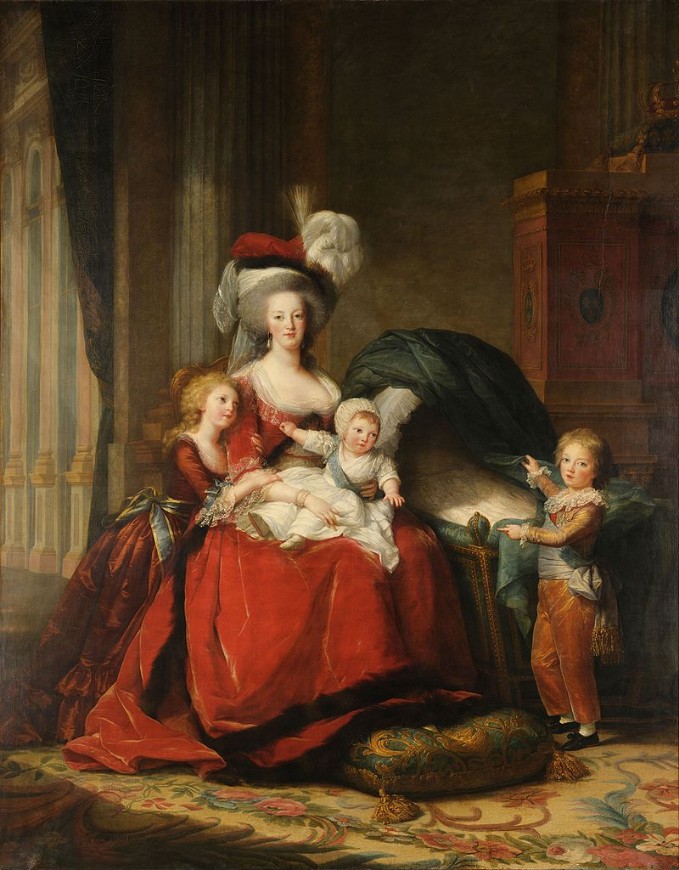
Neoclassical Sculpture
A reaction against the “frivolity” of the Rococo, Neoclassical sculpture depicts serious subjects influenced by the ancient Greek and Roman past.
Learning Objectives
- Explain what motifs are common to Neoclassical sculpture.
Key Takeaways
Key Points
- Neoclassicism emerged in the second half of the 18th century, following the excavations of the ruins of Pompeii, which sparked renewed interest in the Graeco-Roman world.
- Neoclassical sculpture is defined by its symmetry, life-sized to monumental scale, and its serious subject matter.
- The subjects of Neoclassical sculpture ranged from mythological figures to heroes of the past to major contemporary personages.
- Neoclassical sculpture could capture its subject as either idealized or in a more veristic manner.
Key Terms
- verism: An ancient Roman technique, in which the subject is depicted with heightened realism, including advanced age.
As with painting, Neoclassicism made its way into sculpture in the second half of the 18th century. In addition to the ideals of the Enlightenment, the excavations of the ruins at Pompeii began to spark a renewed interest in classical culture. Whereas Rococo sculpture consisted of small-scale asymmetrical objects focusing on themes of love and gaiety, neoclassical sculpture assumed life-size to monumental scale and focused on themes of heroism, patriotism, and virtue.
Neoclassical sculptors benefited from an abundance of ancient models, albeit Roman copies of Greek bronzes in most cases. The leading Neoclassical sculptors enjoyed much acclaim during their lifetimes. One of them was Jean-Antoine Houdon, whose work was mainly portraits, very often as busts, which do not sacrifice a strong impression of the sitter’s personality to idealism. His style became more classical as his long career continued, and represents a rather smooth progression from Rococo charm to classical dignity. Unlike some Neoclassical sculptors he did not insist on his sitters wearing Roman dress, or being unclothed. He portrayed most of the great figures of the Enlightenment, and traveled to America to produce a statue of George Washington, as well as busts of Thomas Jefferson, Benjamin Franklin, and other luminaries of the new republic. His portrait bust of Washington depicts the first President of the United States as a stern, yet competent leader, with the influence of Roman verism evident in his wrinkled forehead, receding hairline, and double chin.
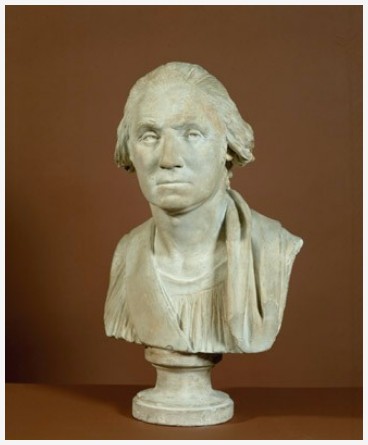
French Neoclassicism continued to be a major force in academic art through the 19th century and beyond—a constant antithesis to Romanticism or Gothic revivals.
American Art
The last quarter of the 18th century was one of Revolution. The American, French and Industrial Revolutions all became historical milestones and were represented in art at the time. Some might argue that the French Revolution was brought on, in part, by the financial help Louis XVI gave to the American revolutionaries in their war for independence against France’s hereditary enemy, England. In any event, the heroes of that war became often reproduced in both painting and sculpture in both Europe and America.
The 18th century saw many American artists, frustrated by their lack of access to education and examples of great art in museums and collections, decamp to Europe – often England – where they made every effort to learn to paint in the academic style. One of the most important of the early American artists was John Singleton Copley. Copley was from Boston and received what art education he had from his stepfather, a successful London mezzotint engraver who had emigrated to the colonies. Copley absorbed the lessons he could, but his work at this period maintained the specific linearity which Barbara Novak has pointed out as a hallmark of American painters who were trying to copy the only models they had – the prints sent over from England.
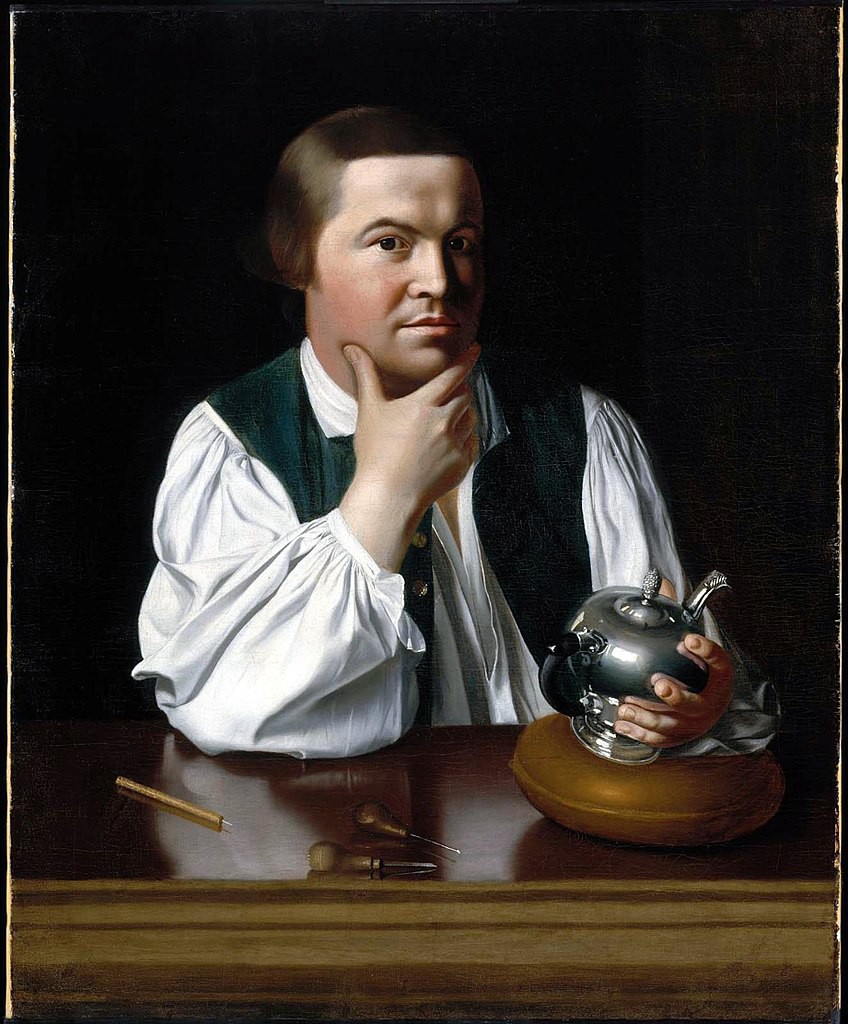
In this portrait of a fellow-Bostonian who was to become a hero of the Revolution you see the well-observed but frozen-in-time look of the Americans. Copley would go to England and study with Benjamin West and Joshua Reynolds, but some suggest that his purely American work is, in fact, superior.

